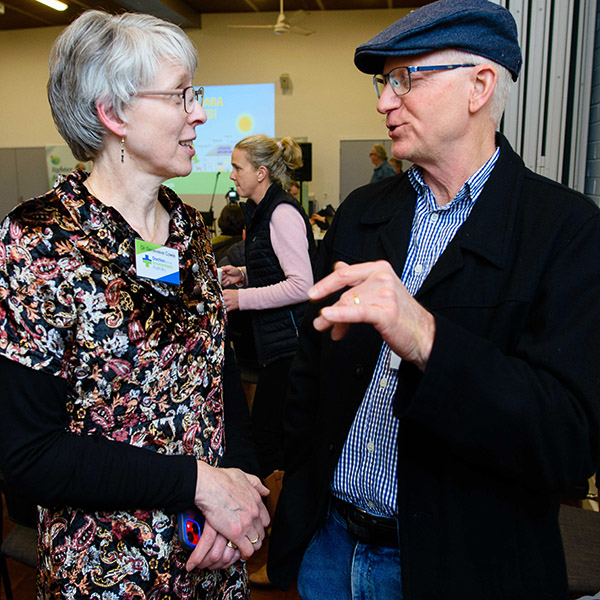On May 24th Lighter Footprints was delighted to welcome home energy expert Tim Forcey and public health physician Dr Genevieve Cowie to our meeting on electrification. The summary below has blue links in bold to the full video presentation chapter points. You can also:
- Watch Tim Forcey in only five minutes! Entertaining video highlights
- Household gas health impacts – Dr Cowie highlights here
- Download Tim Forcey’s slide set here
- Download Dr Genevieve Cowie’s slideset here
- Look at images of the evening and key slides in our Facebook album here
- Check out the tweet string with slides and notes

Lighter Footprints members together with speakers
Make the switch
By switching your appliances from gas to electricity, you can save money on your household bills, improve your family’s comfort, protect them from gas health impacts, and take action to help stop climate change.
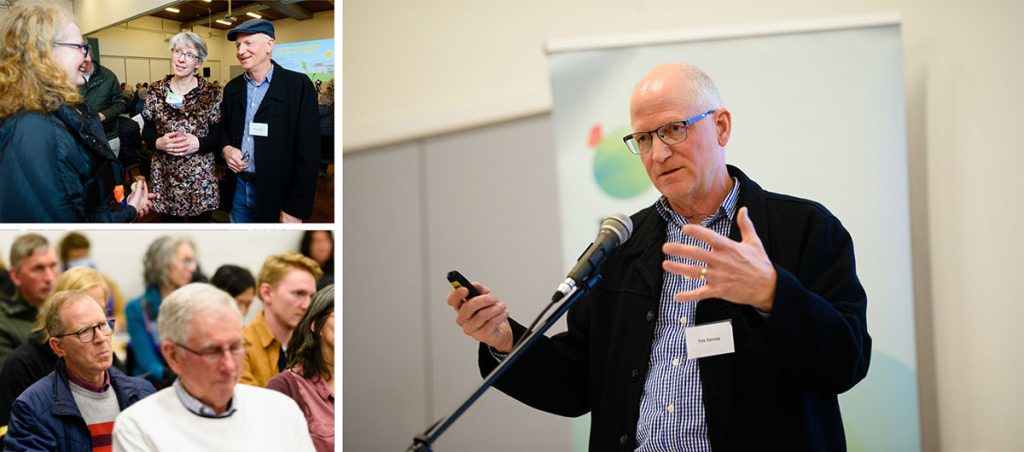
Dr Genevieve Cowie and Tim Forcey both advocate moving from gas to electric from the perspectives of efficiency, price and reduced health impacts
“But first off, I’d like to say who here, get ready to put up your hand.
Who here would like to get a gas bill for the rest of your life?Okay, nobody?
Shucks.”
Tim Forcey, home energy expert
Tim Forcey on electrification
Tim Forcey offered some context to the insights in this discussion of the benefits of going electric. He has worked with over 1,000 families in going electric with energy audits and advice, and founded My Efficient Electric Home Facebook group (MEEH) which is now up to 87,000 members. MEEH is now one of the largest searchable databases that exists on electrification, offering practical advice and solutions to members on their electrification journey. He founded MEEH after doing research at Melbourne University eight years ago, which confirmed the savings from using efficient electric appliances, including a large number of people who did not realise that they could simply heat their house with their reverse cycle air conditioner.
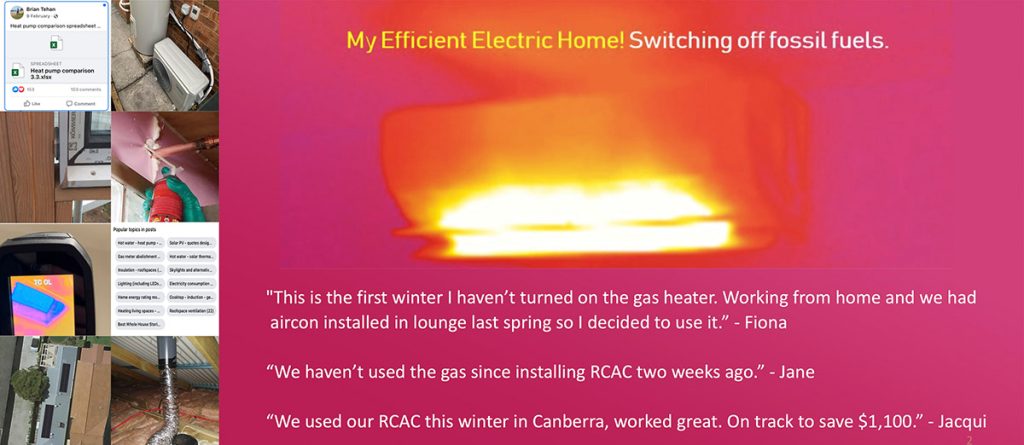
The facebook group My Efficient Electric Home carries practical advice, polls, heartfelt stories both tragic and triumphanant from 87,000 members on their way to comfortable, low energy homes
Gas is not clean, it’s no longer cheap, and it’s running out
Gas isn’t cheap, supply is no longer assured and it isn’t clean either. Bass Straight gas is running out, but instead of importing gas from Queensland we could crash demand through electrification.

Comparison of gas forecasts of 2018 and 2025 – the red area is Bass Straight gas, and the yellow, gas from Queensland – gas is running out
“So that’s just what the coal seam gas looks like up in Queensland.
People live among those wells, or at least they used to.”
Tim Forcey, home energy expert
Gas isn’t clean.
Gas production creates massive degradation of agricultural areas, for instance within valued areas such as the wine producing area in South Australia.
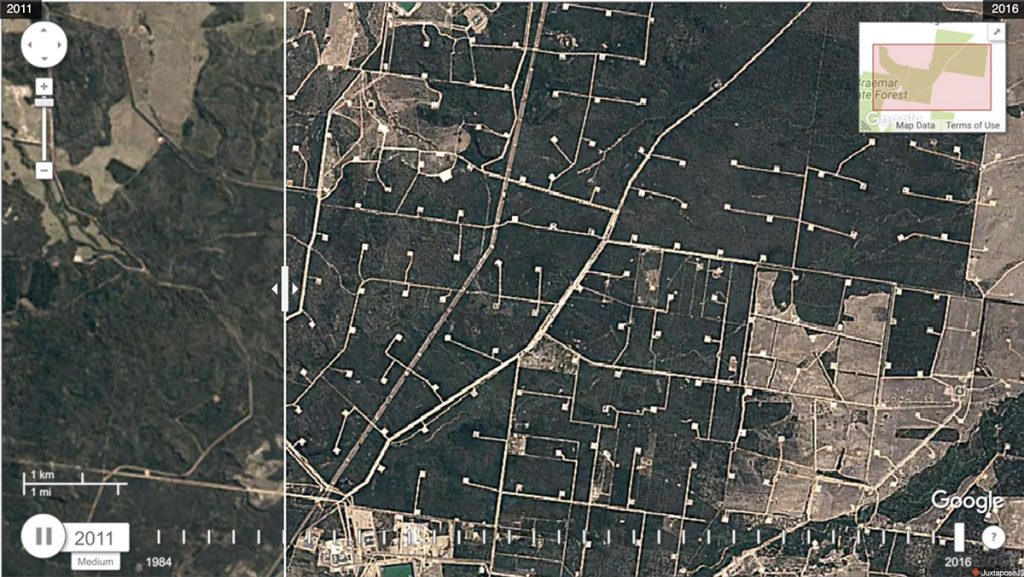
Visual comparison of Breamar State Forest landscape in Queensland before and after fracking well pads
Tim Forcey highlighted map with 300 gas wells in a before and after map comparison. You can see more sliding map comparisons here, showing how difficult it is for people to live and farm in these industrialised gas production landscapes.

NASA satellite data shows methane emissions clustered around pipelines and oil, coal and gas production fields
Methane is a very potent greenhouse gas. There is considerable leakage in urban areas from the gas network which can be tracked by new high resolution satellites. Methane also spills from coal, oil and.gas production, especially around pipelines, as evidenced from satellite data from NASA’s carbon measuring system , and the newer GHGSat Iris, that can resolve methane plumes to 100 feet – methane “accounts for about 30 percent of global warming today.”
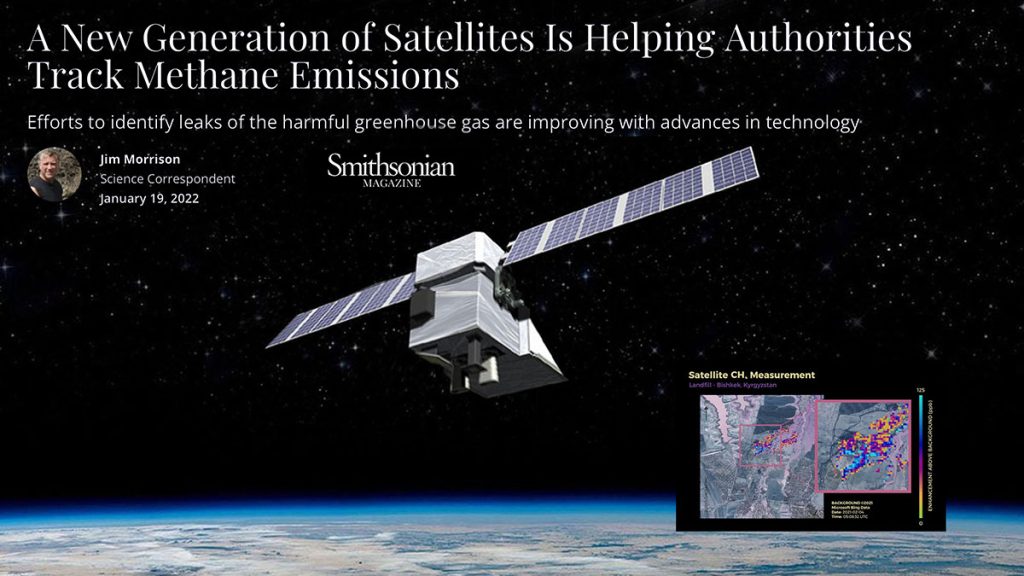
New generation satellites can track methane leakage much more precisley, revealing large amounts of leakage from urban and production areas
“Let’s get our homes off gas and on to heat pumps because you can save money.”
Tim Forcey, home energy expert
Time to move to cleaner, more affordable electric appliances
The good news is that we can move to modern electric appliances using super efficient heat pumps
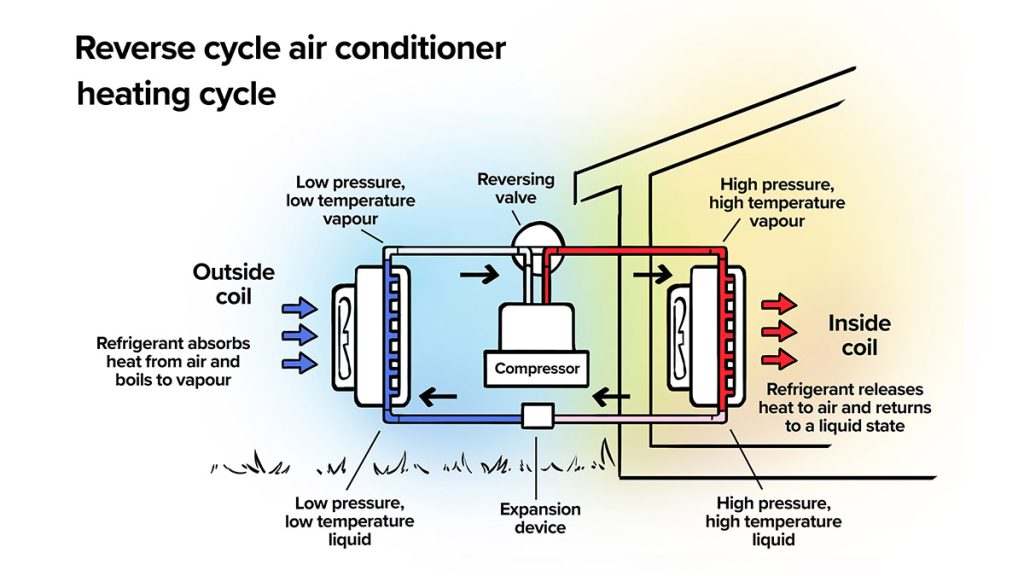
How a heat pump works -energy flows for the heating cycle in a reverse cycle air conditioner
This is a reverse cycle air conditioner. It’s a heat pump. They have refrigerant in them, which goes outside, collects free heat from outside, even if it’s cold outside.
So one unit of electricity into one of these to run the fans and compressors. You can get four or five units of heat coming out of it.
Where did all that free heat come from?
It came from outside your house.
Tim Forcey, home energy expert

Heat pumps are very efficient, heating for well below half the cost of heating with gas
Reverse cycle air conditioners can heat your house for one third of the cost of gas space heating, because they are very efficient. For some people, all they have to do is find the heat cycle button on the air con remote.
“So one unit of electricity into one of these to run the fans and compressors. You can get four or five units of heat coming out of it.
Where did all that free heat come from? It came from outside your house.
So this is why the economics are so fabulous. The gas industry can’t compete with something that’s like 500% efficient.”
Tim Forcey, home energy expert
“The gas industry likes to talk about “Oh, it’s really expensive for people to electrify”, but in some cases, go find two AA batteries, put them in the remote control, find the heat button, turn it on, and you can start saving immediately. That’s not a huge expense.”
Tim Forcey, home energy expert
Heating your home is even cheaper with solar panels.
Heat pump hot water. With so many different rebates, it may be possible to change over for as little as $1000 for one of the cheaper brands.
“So this is a hot water heat pump, same technology, reverse cycle technology that gets heat out of the air and puts it in your water for like a third of the cost of gas or a tenth the cost of gas if you can set this thing up to run on a timer with your solar panels.”
Tim Forcey, home energy expert
Induction cooking – it is possible to use a wok, and induction cooking is much safer, especially with children. Spills are easy to wipe up.
Going electric saves money and it’s safer
Victorians could save $2-3 billion a year by stopping burning gas in buildings.
We might hear gas supply being in the news as a concern.
My option is not to, you know, go frack Victoria to find more gas, which could take ten years to bring online anyway.
What we can do tomorrow is to get people to be using the air conditioners they already own for heating. So we could put a big dent in the gas demand practically overnight.
Tim Forcey, home energy expert

Comfortable electrified home with induction cooking, heat pump hot water and space heating, and EV coupled with attention to the thermal envelope
You can find out more about Julie’s electrification journey in this two minute video highlights on the Electrify Boroondara YouTube channel.
Electric appliances are safer in your home than gas

Victorians are wasting billions of dollars a year by using gas space heating instead of the heat cycle on their reverse cycle air conditioners. More and more people are disconnecitng from gas
Getting rid of the gas meter is really a thing! Although there have been some fascinating stories of charges up to $1500, Victorians will now be charged $220 (and gas companies will be allowed to add a bit more to the bill for faster depreciation).
Don’t forget the thermal envelope
Fixing draughts and leaks is particularly important with the slow and steady kind of heat from a reverse cycle air conditioner compared from blasts from gas ducted heating. Heavy curtains with pelmets are particularly effective. Ventilation management is important – condensation from houses trapping moisture and cold windows exacerbates mould. And it is not at all good to hang up wet clothes to dry inside!
Sandringham house case study
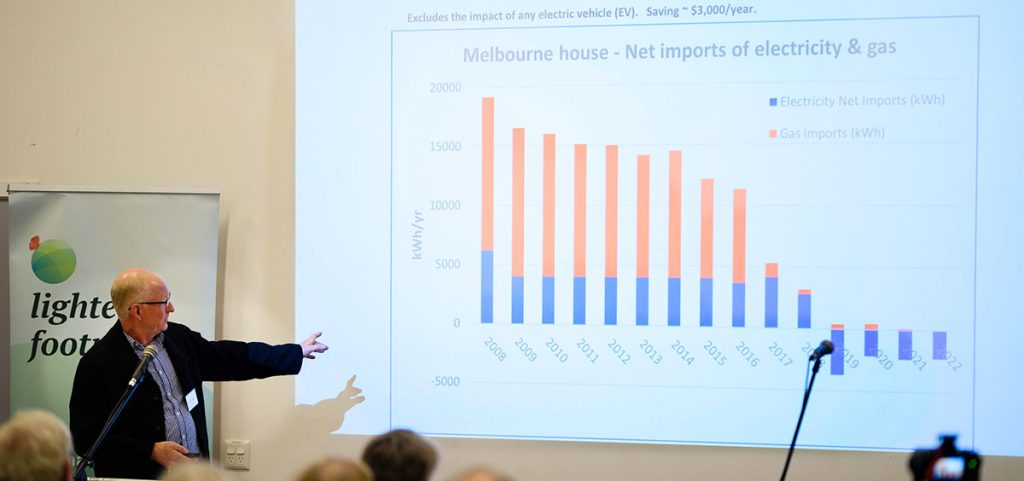
Tim Forcey shows how energy imports fell with electrification and solar. His house now saves $3,000 per year
Tim noted that he only “did one thing a year”, and that we could go electric much faster. He started with some solar panels, back in the John Howard days, then worked on energy efficiency, reducing gas use. “But where you see the gas use drop off in 2017, that’s when we started heating the place with the air conditioners, instead of using the ducted gas heating,” he said. After that it was 22 more solar panels, and finally swapping out the gas cooktop for induction. So now the house is “a net exporter of energy”, saving around $3000 per year.
Tim Forcey indicated indicated that although Victorian Gas Substitution Roadmap indicates a shift away from gas, we have a long way to go!
Dr Genevieve Cowie – health impacts of gas in the home
Introducing Dr Genevieve Cowie, Convenor of Doctors for the Environment Australia’s Research, Education and Advocacy Committee and public health physician.
Dr Genevieve Cowie talks about health impacts of gas in the home. Risks from burning gas or wood are increasingly recognised, affecting our health in many ways.
“The upshot of it all is basically that the risks from burning carbon inside our houses are increasingly recognised, and we now have much safer, healthier and more energy efficient ways of heating our homes and cooking.”
Dr Genevieve Cowie, public health physician
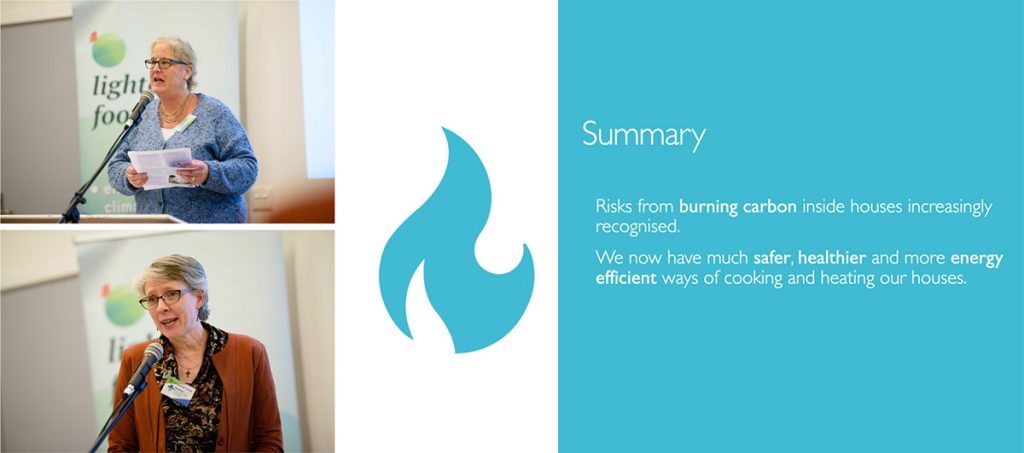
Dr Genevieve Cowie emphasises that we have better solutions than burning gas, coal or wood in our houses – we can avoid gas health impacts and save money by going electric
Poor indoor air quality is linked to health impacts
Dr Cowie listed health risks of poor indoor air quality including from gas appliances, off gassing from furniture and pain. These are made worse by modern building construction with more impervious building envelopes leading to damp and mould unless there is adequate ventilation.
“The safety of gas cooking and heating is not in fact compatible with a tightly sealed modern house.”
Dr Genevieve Cowie, public health physician
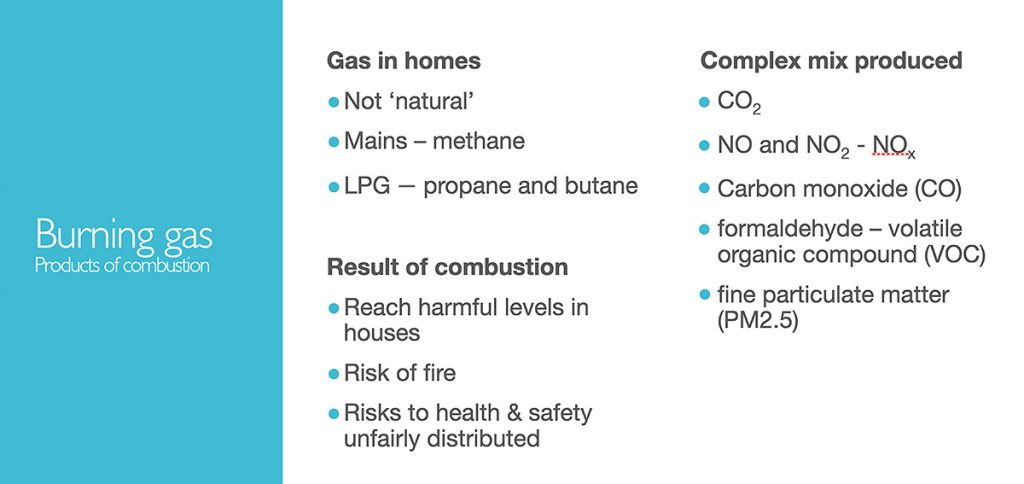
Burning gas in our homes produces many harmful products of combustion
Combustion products including NO, NO2, PM 2.5, CO and formaldehyde
Burning gas in our homes produces harmful combustion products and risks to health which are not evenly distributed across our society. Children and people living in low income areas are disproportionately affected.
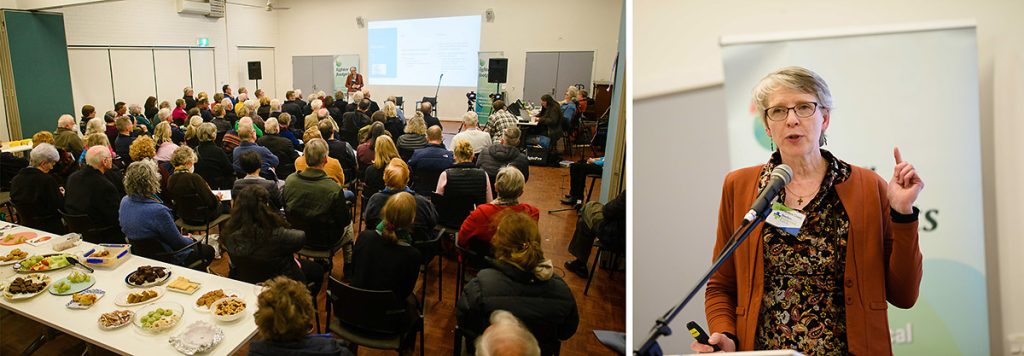
Exhausts are essential,but they don’t take away the all risk of using gas appliances says Dr Genevieve Cowie
Read more about household gas, especially gas cooking and asthma risk, researched since the 1970s
- A recent survey and report by Asthma Australia states that “Cooking with gas is estimated to be responsible for up to 12% of the childhood asthma burden in Australia, which is comparable to the risk of tobacco smoke exposure in the home.”
- A recent US study found that “that 12.7% of current childhood asthma in the US is attributable to gas stove use.”
- A Guardian article noted “risks to children” from “nitrous oxide” and “toxic chemicals”, citing the US study and another article published by the Harvard Medical School which stated that “children living in households that use gas stoves for cooking are 42% more likely to have asthma.”
- This comprehensive Rocky Mountain Institute review found that homes with gas stoves release pollutants, “have nitrogen dioxide concentrations 50 – 400% higher than homes with electric stoves”, and that living in a home with a gas stove “increases their risk of having asthma by 42%”. The levels of indoor pollutants often exceeded outdoor standards.
- This article republished in Renew Economy details how the gas industry knew about health issues from gas cooking from the 1970’s and how this was covered up. In particular a 1972 draft report from the American Gas Association, including “important evidence that the gas industry was not only conducting research into what the NIPCC called the ‘NOx problem‘ became an official government report – however, “an entire section detailing those concerns, entitled ‘Indoor Air Quality Control,’ vanished from the final report.”

Children are more vulnerable to gas stove pollution
Exhausts
Exhausts are only partially effective. Range hoods are noisy, and many families don’t use them consistently. Open flued heater exhausts can be made ineffective from negative pressure in house – for instance when using a shower or stove exhaust fan stoves may leak when turned off.
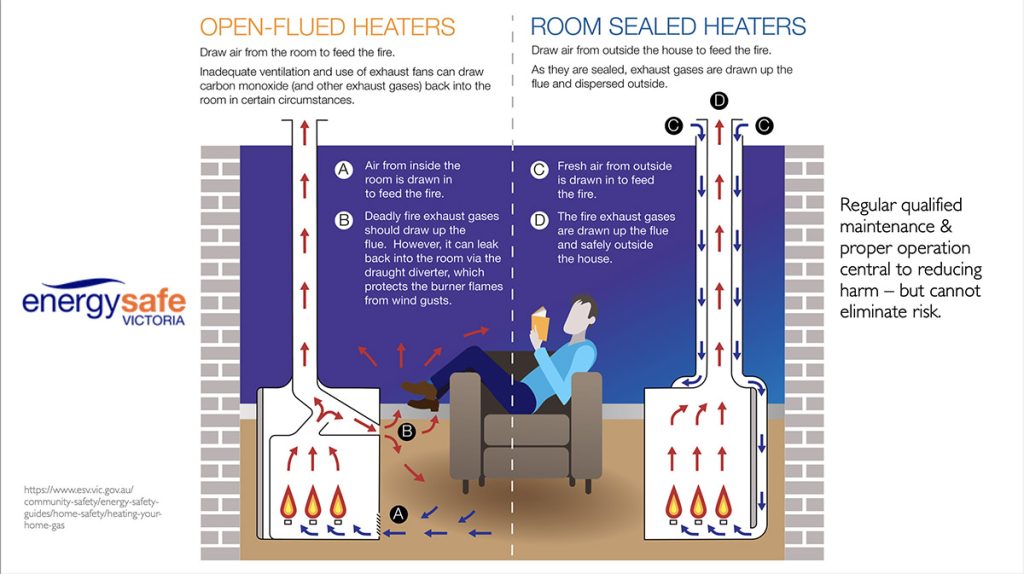
Diagram of the impact of negative pressure on an open-flued heater. Combustion products can enter the room air.
Nitrous Oxide/Nitrous Dioxide
Nitrous oxide is released with burning gas in the house especially gas cooking. It is implicated in asthma. If a child has asthma and there is a gas stove, the gas stove is responsible for 30% of the asthma, and 13% to general population 30:24 PM 2.5 fine particulate matter, aggravates asthma, impacts on chronic obstructive airways disease and heart disease in adults, systemic effects on nervous system including dementia.
Nitrogen dioxide is the best studied of the indoor pollutants.
It’s a potent respiratory irritant. It directly causes airway constriction and sensitisation to allergens like dust mite or pollen.
So for asthma, it’s the clearest association for gas cooking.
Dr Genevieve Cowie, public health physician
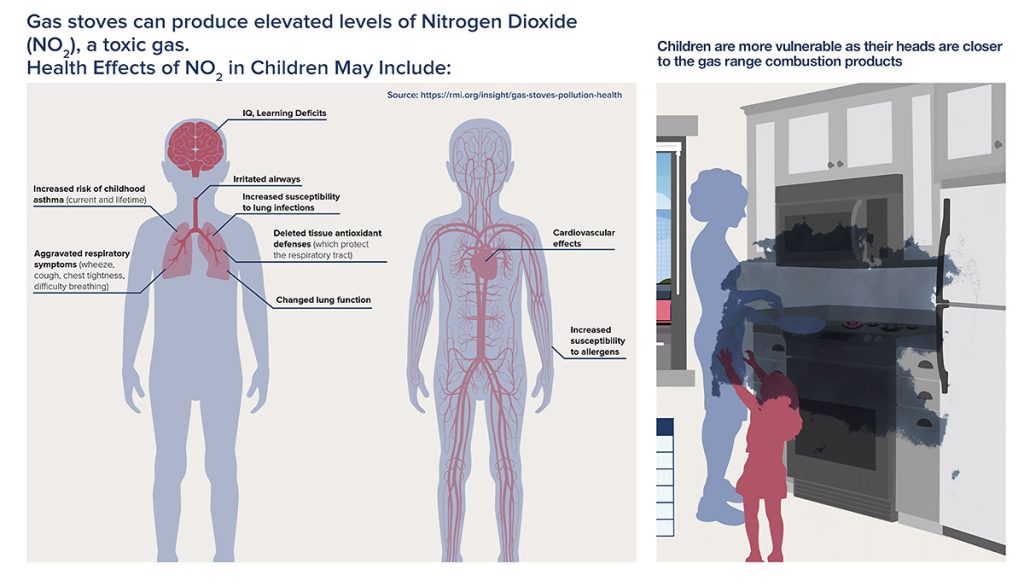
Gas stoves produce Nitrogen Dioxide with wide ranging health impacts in children including asthma, respiratory disease, neurological and cardiac impacts
Fine Particulate Matter
PM 2.5 fine particulate matter, which we are familiar with from bushfire smoke, aggravates asthma. The particles are so fine that they “get breathed right into the deep arts of your lung and into the rest of the body,” and impact many organ systems. PM2.5 has systemic effects including diabetes, poor pregnancy outcomes, chronic obstructive airways disease and heart disease in adults, systemic effects on nervous system including dementia.

Combustion products, particularly from gas cooking, impact multiple organ systems including heart and nervous system, not just the respiratory system
Formaldehyde
Formaldehyde is present with burning gas, a potent irritant, and is a known carcinogen
“Now, formaldehyde is one of those volatile organic compounds.
It’s highly toxic and easily inhaled. It’s present in small amounts in the products of combustion and is also very irritating to the eyes and skin, and is well known is for causing cancer.
it’s a known carcinogen.”
Dr Genevieve Cowie, public health physician
Health risks from formaldehyde and benzene from gas cooking and indoor gas
- This comprehensive Rocky Mountain Institute review noted formaldehyde as a gas stove combustion product, citing EPA studies and a study that concluded that “cooking on the gas stove without venting would expose 53 percent of occupants to formaldehyde levels exceeding health-based guidelines.” (Refs 31, 32, 72, 76, 112).
- A Royal Australian College of GPs news note draws attention to the health impacts of gas stoves and states “Gas flames release both nitrogen dioxide and formaldehyde which are respiratory irritants.”
- A 2023 Rocky Mountain Institute update notes “gas delivered to stoves contains air toxins and chemicals such as benzene, a known carcinogen with no safe exposure level”, citing recent research from Dr Eric Lebel, Stanford and team which found that gas “leakage from gas stoves and ovens while not in use can result in indoor benzene concentrations … comparable to environmental tobacco smoke.”
- A recent Guardian article headlined “Gas stoves emit benzene levels above second smoke, US study finds” states “Even low doses of airborne benzene raise the risk of a variety of cancers, including lymphomas and leukemia”. This study, also from Stanford, found benzene levels above health benchmarks for up to six hours after gas stove and oven use, including elevated levels in bedrooms.
Carbon Monoxide (CO)
Carbon monoxide is a powerful poison and can spill out of gas appliances, especially if poorly maintained, mimics gastro, dizziness, vomiting, suspect if sick just when at home or all people in house are sick at once including pets.
“We know that draft proofing our houses is important, but it’s a problem if you’re burning carbon inside your house. it’s really important for you to service your gas appliances at a minimum of every two years by a licensed gas fitter with a type-A licence and a carbon monoxide meter, which they’re all supposed to have.”
Dr Genevieve Cowie, public health physician
It is important to service appliances regularly, due to CO poisoning risks. There is a new standard for open flued heaters, but they can still spill CO for 15 minutes. Emergency action with CO poisoning includes immediate evacuation, turning off appliances and not using it again until it is fixed or replaced.
Wider health considerations of burning gas in your homes
Gas appliances also impact outdoor air quality for neighbours, especially with temperature inversions.
Burning gas causes pollution and worsens climate change, with substantial health impacts. “Our health depends on having a healthy environment”. Dr Cowie lists health impacts of climate change including food and water safety and security, air quality impacting respiratory and heart and health, increased infectious disease, heat related disease and impacts on our mental health.
What can we do right now?
Interim measures to protect our health on the way to full electrification include improving ventilation, using a portable induction stove, check safety alerts and get your appliances serviced, don’t leave gas appliances operating at night, install a CO alarm and never bring an outdoor gas appliance indoors.
Sleep safely. Don’t leave your gas heating on at night time or for extended periods of time. That increases the risk that you will never wake up.
Dr Genevieve Cowie, public health physician
Audience Questions
Q1 Putting a heat pump into a gas boiler heating system
Existing gas ducts are often too small for a heat pump powered ducted system, and very dusty as filters often have been removed. Some people are not aware that “central heating” requires doors to be open to work, when, for instance in a bedroom, many prefer doors to be closed. In the end most people replace ducted systems with several reverse cycle air conditioners.
“And I guess I encourage people that you don’t really have to have hydronic in the Melbourne climate if your house has a good thermal envelope. That’s insulation, drought proofing, all of that and you should be able to get quite by quite comfortably with a reverse cycle air conditioner just taking over.”
Tim Forcey
Q2 What about tall ceilings and heat pumps?
Look at your thermal efficiency basics, consider using fans to shift hot air down, although this may make you, putting heat pumps lower down, as is common in New Zealand and Tasmania.

Lighter Footprints members asked questions on moving forward from gas ducted heating, refrigerants, gas health impacts, gas and political change and nitty gritties like removing your gas meter
Q3 Refrigerants in heat pumps
There is still some ozone destroying R22 refrigerant around. Unfortunately some modern substitutes have global heating potential 1,300 times of CO2. CO2 itself is a refrigerant, also propane, which has no global heating potential, but is very flammable. Isobutane is very common. It’s worth going into a good showroom and do your research – there is a balance between global warming potential and flammability.
Q4 Removing your gas meter
Tim Forcey recounts a variety of stories, some not so amusing, of charges up to $1500 to remove your gas meter. Since then the charge has been fixed at $220 by the Australian Energy Regulator. You can read Tim Forcey’s and Alan Pear’s discussion here.
Q5 Is 3 phase power necessary to go all electric?
Not really for ordinary electrification including induction cooking. However installing 3 phase might help with very fast EV charging, increase your allowable PV exports, or help with arc welding!
“3 phase could be good in a few situations. For example, maybe here you’re limited to only exporting five kilowatts from your solar PV system, but that’s per phase. So if you had 3 phase, you could export 15 kilowatts. If you had 3 phase, you could charge your car faster than what you’re going to be able to do on single phase. But you don’t need 3 phase for an induction cooktop. You don’t need 3 phase, for as many split systems as you’re going to need. And the last one I can think of is if you’re into arc welding, then you might need 3 phase.”
Tim Forcey
Q6 Are health impacts sufficient for governments to ban gas stoves?
Governments need to feel safe, hence work needed on community understanding of health risks. People have an emotional attachment to gas cooking – sure it was much more responsive than coal ranges or previous type of electric cooking – but we have all that responsiveness and more with induction cooking. Understanding the link with gas cooking to asthma, and other health impacts can help with the shift.
“But, you know what governments are like, they don’t like to lead the way too much. So essentially the problem will be that so many people are still so fond of their gas cooktops. Until the government feels that there’s a community upswelling about it, it’s very unlikely that they would take that option. I think the energy security angle and supply might be better, but quite frankly, both federal and state governments are still captured by the gas, the fossil fuel industry.”
Dr Genevieve Cowey
Q7 Can you retain gas ducted system and just an use electric heater with ducts?
Gas ducted systems needs doors closed. Often ducts too small, and clients find that the ducts are very dirty, as either the filters have been removed, or they were never there in the first place. When shown the state of the ducts, it can be enough for people to never use them again! Usually people move to a combination of split systems.
Q8 Neurological impacts of burning gas in home
There is research linking the combustion products produced when gas is burnt in the home with poor obstetric outcomes, dementia. Children are at risk.
“But breathing contaminated air is not a good for a growing baby and for the mother.
We can do better. We don’t have to wait for the proof. We can do better already.”
Dr Genevieve Cowie
Q9 Short term actions for renters with gas to reduce risk
Ventilation – opening the kitchen window when cooking, insist on regular servicing, try and keep the moisture down and damp and mould make asthma worse.
The Electrify Boroondara Project
Introducing Mark Cubit, Chair of the Electrify Boroondara Steering Committee
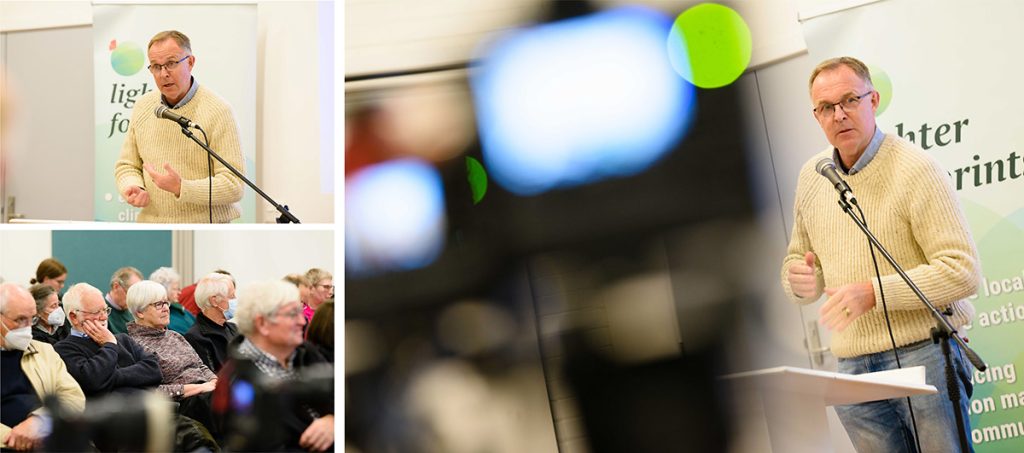
Mark Cubit, Chair of the Electrify Boroondara Steering Committee, introduces the Electrify Boroondara project
Mark Cubit on the Electrify Boroondara project , an alliance of local community groups fostering electrification of households and transport in Boroondara. Visit the Electrify Borooondara website here.

Members of Lighter Footprints Electrify Boroondara Working Group are selling copies of Saul Griffith’s The Wires that Bind and the Big Switch
What to do next
- Interested in joining Lighter Footprints Electrify Boroondara working group? Head to our Take Action page and tick the second check box.
- Keep up to date with the Electrify Boroondara project here.
- Got two minutes? Listen to Cr Wes Gault and local residents talk about electrification on our EB promo video here.
- Find out more on our Making the Switch page – more on electrification benefits, accessible research on health impacts and more.

